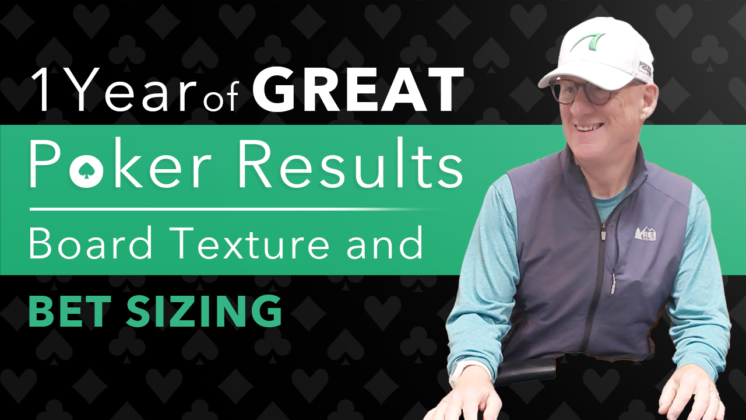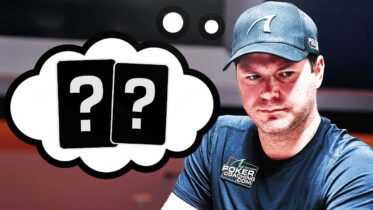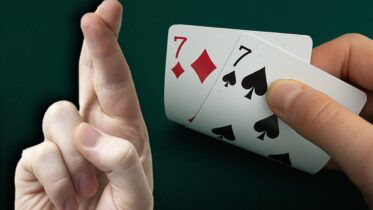This chapter continues my discussion about specific poker strategies that have helped me, including board texture and bet sizing. If you wish, you can start reading at Chapter 1, or download the entire e-book as a PDF.
Hyper-sensitivity to Board Texture
A big lesson I learned from studying poker theory is the importance of board texture. I already had some understanding, even back in my limit hold’em days. But the new me has truly grokked how the board controls who gets to bet, and how much.
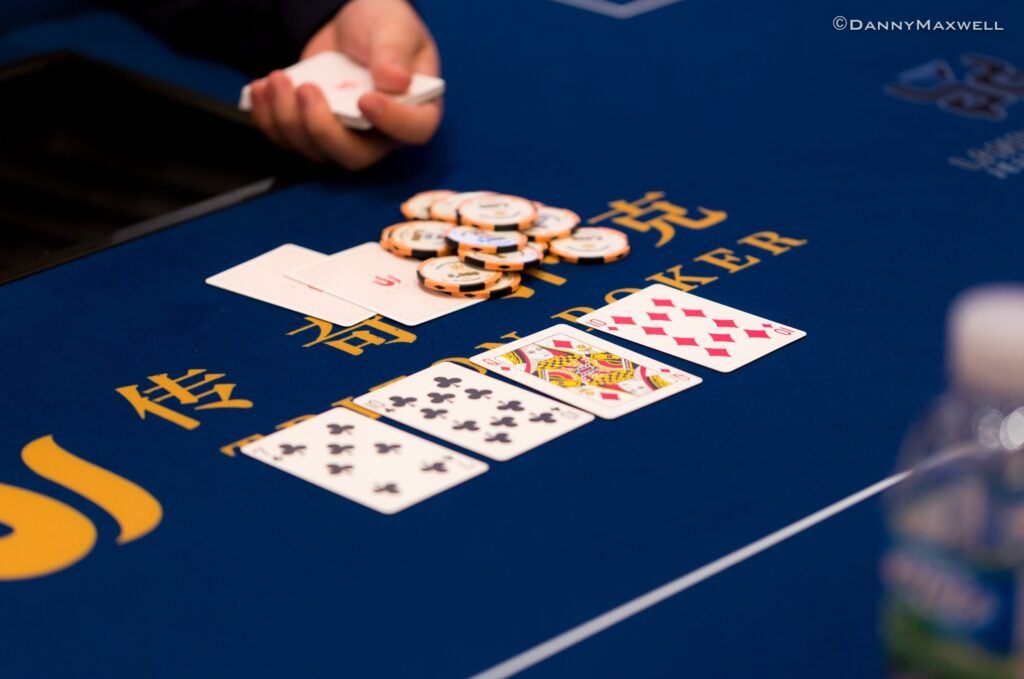
This is an area where I see unstudied players make the biggest errors. There is a reason why the solver turns defensive on a board that doesn’t favor its preflop range, but many old-school players don’t get it. They plow forward with an overpair, but are lost when suddenly an opponent is representing a stronger hand on a board full of scary possibilities.
In particular, I can now look at a board, and think, “That’s all me,” meaning it smashes my range, if not my particular hand. Or conversely, I see a board that whiffs a large portion of my range, and I think, “I need to tread delicately here.”
I think about how my range coordinates with the board, rather than how my specific hand connects with it.
I still like flopping top pair, top kicker and sets as much as anybody, but I sometimes win pots simply by knowing that the board coordinates well with my range, but poorly with my opponent’s. If the board doesn’t coordinate with my range, I don’t throw good money after bad trying to represent a hand I’m unlikely to have.
Suppose I’m playing $2/$5 NLHE with $500 stacks, and I open-raise to $20 from UTG+2. Everybody folds around to the big blind, who calls. So there’s $40 in the pot, and the flop is Q-T-4 rainbow. The big blind checks.
Before my graduate poker study, I would have bet or not as a function of how hard my hand hit the flop. I’d bet my queens, overpairs, maybe KJs. Well, I checked the solver, and it bets this spot 86% of the time (mostly B33). I’m not that nuanced, so I “bet range” here. That is, I’m betting every hand that got to this point.
Conversely, suppose the positions are reversed – my opponent opens for $20 UTG+2, and I call in the big blind. The flop is 8d-4c-3d. I check, and my opponent bets. Already, things are a little suspect – the solver only bets in their spot 39% of the time. Why? Because a lot of the preflop raiser’s equity is tied up in unpaired overcards. Those overcards are put into a tough spot by a check/raise, which the solver anticipates happening with reasonable frequency.
Unstudied players often feel that, having raised preflop and been checked to, it is their right and obligation to c-bet every time. And c-bet they do, even with hands that the solver would always check. If I whiffed the flop, their bet works, and I fold. However, my definition of “whiffing” has changed dramatically. If I have a decent draw to a draw, that may be enough to continue. Why? Because I may suspect that my opponent is simply c-betting “range,” which means they are often betting with weak hands. As legendary poker author Ed Miller put it, “Those weak hands have to go somewhere.” The somewhere I’m thinking about is the muck.
If I have three to a straight and three to a flush, I may call, or even check/raise. If they call my raise, and I get a favorable turn card, I’m going to hit them with a bet on the turn. Even their overpairs are put in a very difficult situation, and their unpaired big cards can’t continue. Of course, I’ll have some sets and two-pairs in that mix as well – it’s the very real threat of a monster that confuses and scares my opponent.
All because I’m leaning into my understanding of board texture.
Getting Better at Bet Sizing
One of the most radical changes I’ve made is how I size bets on the flop and turn. Bet sizing is the most complex topic within no-limit hold’em. I am far from an expert in it, but I’m doing a lot better than I did five years ago.
Here’s an interesting experiment: pick a player at your table, and watch their bet sizing. You will find many folks who always bet somewhere between 50% and 100% of the pot. But no-limit hold’em permits the bettor to wager anything from one BB to the effective stack. Limiting oneself to this 50%-100% range is playing with an arm tied behind the back. I’ve untied that arm, and I play better with two arms.
Frequent Small Bets on the Flop
Medium-strength hands tend to be the worst for betting, and they are also the hands that benefit most from a smaller size when they do bet. So in spots where I’m betting less often, these are the first hands that get dropped from my betting range. Everything else (the polar points of my range) benefits from a larger size. In spots where I want to bet medium hands, I use the smaller size to accommodate them, and then make up the difference with my strongest and weakest hands by betting larger and more polar on later streets.
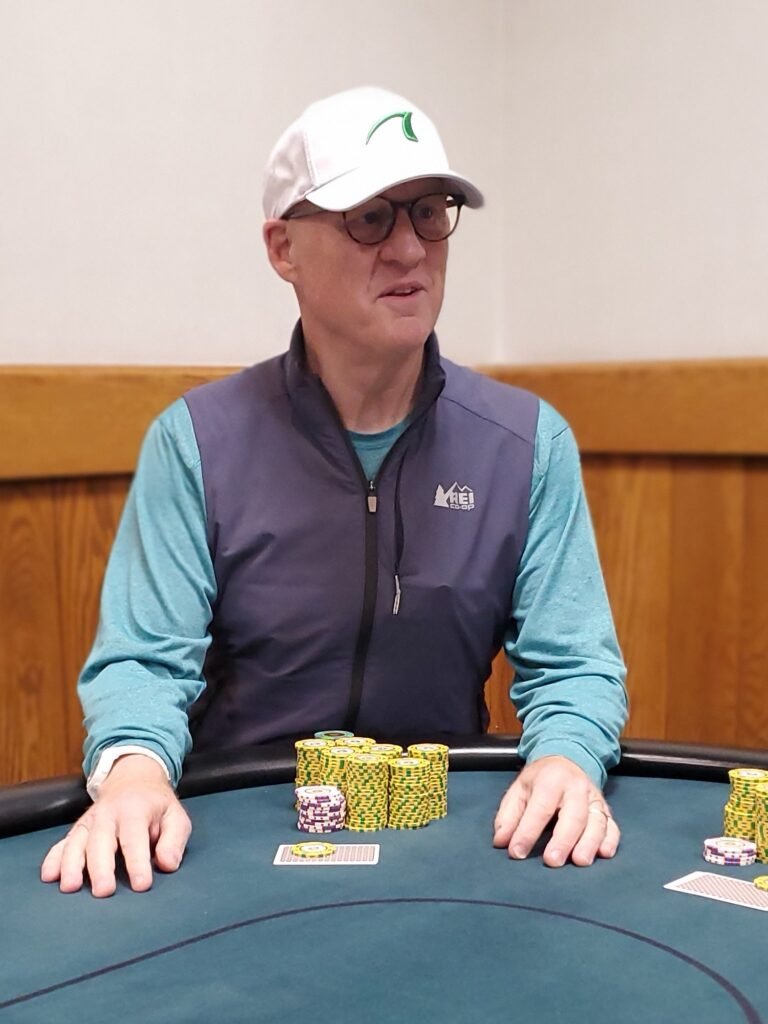
The small flop bets are a relatively new phenomenon in the live poker world, and many old-school players don’t give them much respect. I get quite a few calls on the flop from people who have completely whiffed, but their egos won’t let them fold for such a small bet.
These “Your bet is insultingly small” calls actually trend theoretically correct. That is, the smaller my bet, the weaker the hands my opponent can profitably call. That’s just how pot odds work. But few people know how to defend against small bets with marginal holdings, especially out-of-position. Frankly, I find it difficult, and I study it more than they do.
In the old days, Ialwaysbet big on the flop when I held a medium-strength hand. Now I know that this is usually a mistake. The hands that call will have good equity, and now I’ve put extra money into a pot that I may not be a favorite to win. The bad hands that fold, I was probably ahead of those anyway.
The B25 or B33 flop bet keeps weak hands in. Those hands rarely improve on the turn, and people holding them tend to make expensive mistakes.
Big Turn Bets
When we get to the turn, and I’m in-position, theoretical bet sizes are more polar (very strong hands and bluffs/semi-bluffs). So now I’m betting larger. And a huge majority of my pots are played in-position. I don’t have 3-4 bet sizes like the solver does, but I do have what I’ll call “L” and “XL” sizes. “L” is perhaps B75 (75% of the pot), and “XL” is B125 or B150. These sizes are solver-approved, though again, it has more sizing buckets than I do.
My big turn bets, particularly the XL size, are playing havoc with my opponents. They’re not used to seeing such big bets and have no idea what to do with them.
Geometric Bet Sizing
Finally, I have learned, and use, “2E” (geometric) bet sizing, when appropriate. “2E” sizing means betting a certain percentage of the pot on this street, which will leave exactly that same percentage of the pot for an all-in shove on the next street. For reference, “3E” bets the same percentage of the pot across three streets, with the last bet being all-in.
2E betting is correct when hand values are “static.” That is, the hand that is winning right now is likely to be the ultimate best hand. On the flop, that’s usually indicated by few potential overcards that can come. For example, an ace-high flop is static because no overcard can come on the turn. On the turn, the presence of draws makes the board “dynamic,” which is the opposite of static.
Suppose the flop is A♣️-9❤️-3♦. This is called a static flop because no matter what card comes on the turn, the top pair (aces) remains unchanged. Conversely, if the flop is 9❤️-5♦-2♣️, this is called a dynamic flop because if any card ten or higher comes on the turn, the top pair changes.
Back to the A♣️-9❤️-3♦ flop. There’s a bet and a call. Now the turn is the 9♠️. This is a static board because there are no meaningful draws available; whoever is in front now is very likely to be in front on the river. But change the 9♠️ to the T❤️, and suddenly we have a dynamic board, full of potential draws.
The 2E bet size is important because it puts maximum pressure on my opponent. It sets me up to get stacks in with my strongest hands, while giving me more bluffing opportunities. Specifically, a 2E bet sends a clear message to my opponent that I could shove the rest of the chips on the next street. That gets some folds that I wouldn’t get if there weren’t another street of betting remaining. However, I don’t have to fire that second barrel – just its specter bought me some fold equity.
Properly using “2E” bet sizing has made me a dangerous poker player.
A Before and After Example of Bet Sizing
I’m playing $2/$5 no-limit hold’em, and everybody has $500 (100 BB) stacks. I open in the hijack to $20, and only the big blind calls. With $40 in the pot, the flop is K♣️-T♠️-2❤️. The big blind checks to me.
Back in the old days, I’d only bet if I hit the flop. Kings, maybe a good ten. And I would have bet a large percentage of the pot – around 80%. My thinking (and the general wisdom of the day) was that I wanted to protect against draws and get full value for my good hands from weaker ones.
I had it wrong. I was betting perhaps 40% of my range, and according to the solver, I should have been betting 88% of my range.
And my bet-sizing was wrong too. When the solver bets, 60% of the time it is for a B33 (33% of the pot) size. So that’s less than half of what the old Lee would have bet. This smaller size allows the bettor to cheaply fold out a lot of random junk that the big blind has. But it also keeps in a lot of weak hands that will struggle to continue on future streets.
So now, the new Lee bets $15 (close enough to 1/3 pot) with my entire range.
That’s right – given that I raised from the hijack, the BB called, and checked to me on this flop, I am now betting every single hand that got here, and I’m betting 1/3 pot.
Let’s suppose that my opponent in the big blind calls, so there’s $70 in the pot, and $465 in the stacks. The turn card is the 3❤️, and the big blind checks to me. The old Lee played nearly honest poker at this point. I would check the hands that had minimal value, and check my draws. If I bet, it would be for half pot because – well, because I had no idea of what a good bet size would be, and I saw other people betting half pot.
Now, I check a lot more hands, and the ones I’m betting are more polar. That is, I’m betting my thickest value hands (AK, TT, KT, etc) and my best draws that have no showdown value (A❤️Q❤️, Q♠️J♠️, J❤️9❤️). And here’s the fun part – I’m betting them big – a 2E sizing – which, in this case, is 140% of the pot ($100).
This freaks my opponents out. First, they’re not used to seeing bets anywhere near this big (as a percentage of the pot). Also, they quickly get the message: “All the rest of my chips are going in on the river.”
Does that crazy guy (me) have AK, a set of tens, or a flush draw with a gutshot (aka “jack high”)? Who knows? This puts their Q♦T♦ in a miserable spot.
Nothing makes me happier than seeing my opponent’s shoulders sag and their heads hang. When they’re confused and lost, I’m making money.
If they call, maybe I jam the river, maybe I don’t, but their head is already spinning.
